Kerala Plus One Physics Chapter Wise Previous Questions Chapter 5 Law of Motion
Question 1.
A passenger of mass 30 kg is standing in a lift which is moving vertically downwards with an acceleration of 1.8 m/s² (MARCH-2010)
a) Will the passenger experience a decrease or an increase in his weight? Explain.
b) What will be the effect if the cable is cut and the lift falls freely?
Answer:
a) Weight decreases.
New weight, w = mg ma
= 30 x 10 30 x 1.8
= 300 54
= 246 kg
b) Weight becomes zero.
Question 2.
There are different types of forces in nature. We learnt their effects and applications. Give the exact reasons forthe following. (MARCH-2010)
a) Why does a satellite revolve around the earth in a circular path?
b) Why can’t a horse pull a cart in empty space?
c) Why are passengers thrown forward when a speeding bus stops suddenly?
d) Why is it easy to lift a heavy stone in water?
Answer:
a) Due to the gravitational force of attraction between earth and sun.
b) Horse can’t give action in empty space.
c) Due to the inertia of motion.
d) Due to upthrust produced by liquid on stone.
Question 3.
A man is standing at the centre of a large flat slab of ice. He can get himself to the edge of the slab by spitting or blowing air in the forward direction (assuming the ice to be frictionless). (MAY-2010)
a) Name the principle/law involved in this.
b) A horse cannot pull a cart and run in empty space.Why?
c) With the help of a free body diagram represents the various forces acting on a vehicle moving on a banked road. Neglecting frictional force obtain the expression for the maximum safe speed of the vehicle on the banked road.
Answer:
a) Newtons III law of conservation of momentum.
b) Horse can’t give action and not able to avail reaction as like in-ground.
c)
a)
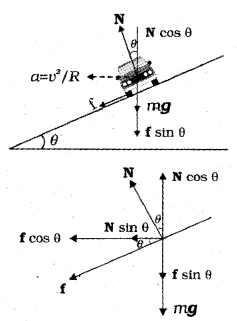
b) Consider a vehicle along a curved road with angle of banking θ. Then the normal reaction on the ground will be inclined at an angle θ with the vertical.
The vertical component can be divided into N Cosθ (vertical component) and N sinθ (horizontal component). The frictional force can be divided into two components. Fcosθ (horizontal component) and F sinθ (vertical component).
From the figure
N cos θ = F sinθ + mg N cosθ
N cos θ – F sinθ = mg …..(1)
The component Nsinθ and Fsinθ provide centripetal force. Hence
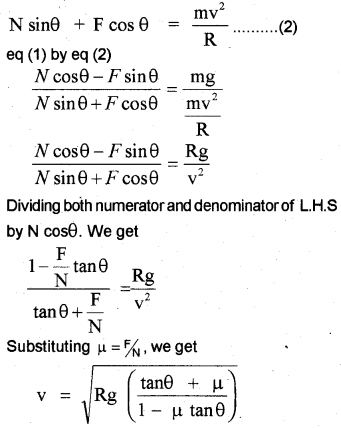
This is the maximum speed at which vehicle can move over a banked curved road.
Optimum speed : Optimum speed is the speed at which a vehicle can move over a curved banked road without using unnecessary friction.
Putting μ = 0 in the above equation we get
![]()
Question 4.
Raising the outer edge of a curved road a little above the inner edge is called banking of curves. (MARCH-2011)
a) Derive an expression for the safe speed with which a car can negotiate a banked road by taking into account the friction between the tyres and the road.
b) A machine gun fires bullets of mass 40g each with a speed 1200 ms1. The person can hold the gun with a maximum force of 144 N. What is the maximum number of bullets that can be fired per second from the gun?
Answer:
a)
a)

b) Consider a vehicle along a curved road with angle of banking θ. Then the normal reaction on the ground will be inclined at an angle θ with the vertical.
The vertical component can be divided into N Cosθ (vertical component) and N sinθ (horizontal component). The frictional force can be divided into two components. Fcosθ (horizontal component) and F sinθ (vertical component).
From the figure
N cos θ = F sinθ + mg N cosθ
N cos θ – F sinθ = mg …..(1)
The component Nsinθ and Fsinθ provide centripetal force. Hence

This is the maximum speed at which vehicle can move over a banked curved road.
Optimum speed : Optimum speed is the speed at which a vehicle can move over a curved banked road without using unnecessary friction.
Putting μ = 0 in the above equation we get
![]()
b)
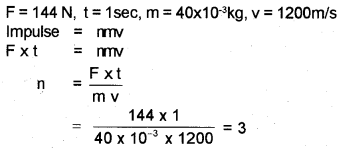
Question 5.
A thief jumps from the top of a house with a box of weight 25kg. wt. on his head. What will be the weight of the box experienced by the thief during his downward fall? Justify your answer. (MAY-2011)
Answer:
Weight experienced by thief during his downward fall is zero. When a body comes down with an acceleration. Weight,
W = mg – ma
for a freely falling body a = g
W = mg – mg
= 0
Question 6.
When a shot is fired from a gun, the gun moves in the backward direction. (MAY-2011)
a) State the principle behind it.
b) Prove the principle using Newton’s second law of motion.
Answer:
a) Law of conservation of linear momentum
b) According to Newtons second law
![]()
If F = 0, we get P = constant
Which means that momentum of a body remains constant, if there is no external force acting on it.
Question 7.
Friction is a force acting between two surfaces in contact; when there is a relative motion between them. Consider a car moving over a horizontal road. What will be the direction of frictional force acting between the road and tyre? (MAY-2011)
Answer:
Opposit to the direction of motion of tyre.
Question 8.
A stone breaks the window glass into pieces while a bullet almost pierces through the same. Give reason. (MAY-2011)
Answer:
When bullet is fired at high speed its time of contact with the glass is very small compared with a stone moving at a low speed.
Question 9.
Banking of road helps to increase the centripetal force and there by increases the limit of maximum speed of vehicle with it can take the curve. (MAY-2011)
a) Sketch the schematic diagram of a vehicle on a banked road and mark the various force acting on it
b) Give the expression forthe maximum allowed speed of a vehicle on a banked road with friction.
Answer:
a)

b) Consider a vehicle along a curved road with angle of banking θ. Then the normal reaction on the ground will be inclined at an angle θ with the vertical.
The vertical component can be divided into N Cosθ (vertical component) and N sinθ (horizontal component). The frictional force can be divided into two components. Fcosθ (horizontal component) and F sinθ (vertical component).
From the figure
N cos θ = F sinθ + mg
N cos θ – F sinθ = mg …..(1)
The component Nsinθ and Fsinθ provide centripetal force. Hence

This is the maximum speed at which vehicle can move over a banked curved road.
Optimum speed : Optimum speed is the speed at which a vehicle can move over a curved banked road without using unnecessary friction.
Putting μ = 0 in the above equation we get
![]()
Question 10.
A block of mass M is suspended by a light cord C from the ceiling and another strong cord D is attached to the bottom of the block as shown. (MARCH-2011)

The cord D is pulled by a force F. Which of these cords will break, if
a) the force is increased steadily ?
b) the force is increased suddenly ?
Answer:
a) Tension in cord C = F + mg Cord C may break.
b) Cord D is strong. Hence C may break.
[There is a mistake in this question]
Question 11.
According to Newton’s law of motion, the force depends on the rate of change of momentum. (MARCH-2012)
a) State whether the force is external or internal? Justify your answer.
b) What happens to the linear momentum when the force is absent?
c) The motion of particle of mass m is described by
![]()
Find the forge acting on the particle.
d) Why is it more difficult to rotate a stone by tying it to a longer string then a shorter string?
Answer:
a) External.
Internal force can’t change the momentum of a body.
b) Linear momentum will be a constant
c)

Then force on a particle
F = ma
F = mg
d) More torque is required if length of string is longer. Hence it is difficult to rotate a stone by tying it to a longer string .
Question 12.
Write the reasons for the following : (MAY-2012)
a) Action and reaction are equal and opposite. Yet they do not cancel each other.
b) A cricketer moves his hands backwards while holding a catch.
Answer:
a) Action and reaction are equal and opposite. Yet they do not cancel eachother because they act on two different bodies.
b) When a cricketer moves his hands backwards the time of catch increases. As a result the force required to stop the ball can be minimised.
Question 13.
Match the following : (MARCH-2013)
| S.No. | A | B |
| 1. | Newton’s first law | Change in momentum |
| 2. | Conservation of linear momentum | Action reaction |
| 3. | Newton’s third law | Lawof inertia |
| 4. | Impulse | Momentum before collision = Momentum after collision |
Answer:
| S.No. | A | B |
| 1. | Newton’s first law | Law of inertia |
| 2. | Conservation of linear momentum | Momentum before collision = Momentum after collision |
| 3. | Newton’s third law | Action o reaction |
| 4. | Impulse | Change in momentum |
Question 14.
According to Newton’s law of motion, the force depends on the rate of change of momentum. (MARCH-2013)
a) Name the law that helps to measure force.
b) Using the above law, deduce an expression for force.
c) A man jumping out of a moving bus falls with his head forward. What should he do in orderto land safely?
Answer:
a) Newton’s second law
b) Consider a body of mass ‘m’ moving with a momentum \(\overrightarrow{\mathrm{P}}\) . Let \(\overrightarrow{\mathrm{F}}\) be the force acting on it for time internal ∆t. Due to this force the momentum is changed from \(\overrightarrow{\mathrm{P}}\) to p + ∆p. Then according to Newtons second law, we can write

c) Run in the direction of bus.
Question 15.
A circular track of radius 400 m is kept with outer edge raised to make 5 degree with the horizontal. (MAY-2013)
a) What do you call this type of construction of tracks?
b) Obtain an expression for the maximum permissible speed considering the force of friction.
c) Calculate the maximum permissible speed of the car if the coefficient of friction is 0.2.
Answer:
a) Banking of road
b)
a)

b) Consider a vehicle along a curved road with angle of banking θ. Then the normal reaction on the ground will be inclined at an angle θ with the vertical.
The vertical component can be divided into N Cosθ (vertical component) and N sinθ (horizontal component). The frictional force can be divided into two components. Fcosθ (horizontal component) and F sinθ (vertical component).
From the figure
N cos θ = F sinθ + mg N cosθ
N cos θ – F sinθ = mg …..(1)
The component Nsinθ and Fsinθ provide centripetal force. Hence

This is the maximum speed at which vehicle can move over a banked curved road.
Optimum speed : Optimum speed is the speed at which a vehicle can move over a curved banked road without using unnecessary friction.
Putting μ = 0 in the above equation we get
![]()
c) Maximum speed

Question 16.
The outer side of a circular track of radius 200m is raised to make an angle of 15° with the horizontal. (MARCH-2013)
a) Which force provides the necessary centripetal force fora cartaking the circular track?
b) Nametheprocessbywhichthe outersideofacurved track is raised a little above the innerside.
c) Using the data provided in this case, determine the maximum permissible speed to avoid skidding. (Given μs = 0.25).
Answer:
a) Friction
b) Banking of road
c) permissible speed
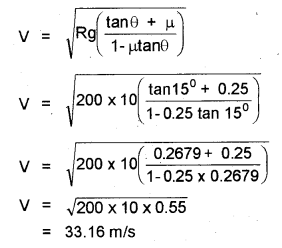
Question 17.
We are familiar with Newton’s laws of motion. (MARCH-2014)
a) State Newton’s second law of motion.
b) Using the above law, explain:
i) Impulse momentum principle
ii) Law of conservation of linear momentum
c) A circular racetrack of radius 300m is banked at an angle of 15°. The coefficient of friction between the wheels of a race car and the road is 0.2. Find:
i) The optimum speed of the race car to avoid wear and tear on its tyres.
ii) Maximum permissible speed to avoid slipping.
Answer:
a) The rate of change of momentum of a body is directly proportional to applied force and takes place in the direction in which force acts.
b) The impulse of the force is product of average force and time for which it acts. Impulse is equal to change in momentum.
ie. F∆t = ∆p
c) When there is no external force on a body, the total momentum remains constant.
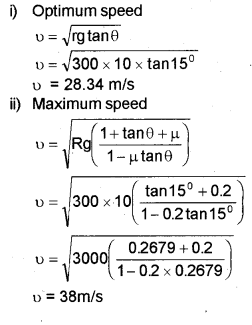
Question 18.
Newton formulated the famous laws of motion. (MAY-2014)
a) Give the significance of Newton’s first law.
b) Action and reaction are equal and opposite, yet they do not cancel each other. Why?
Answer:
a) Newton’s first law give idea of inertia. Inertia is a measure of mass of body.
b) Though action and reaction are equal and opposite, they do not cancel each other because action is on one body and reaction is on another
body.
Question 19.
Friction is defined as the force which opposes the 1 relative motion between two surfaces in contact. (MAY-2014)
a) Friction is a necessary evil, Explain.
b) What is meant by banking of roads?
c) Obtain an expression for maximum speed on a banked road without considering friction.
Answer:
a) Friction has both advantages and disadvantages. Friction help us in holding objects, walking on ground, driving vehicles etc. But it causes wear and tear. Friction leads to waste of energy in the form of heat. Hence friction is a necessary evil.
b) The outer edge of the road is raised slightly above the inner edge. This is called banking of road. In a banked road, component of friction and normal reaction provide necessary centripetal force.
c)
a)

b) Consider a vehicle along a curved road with angle of banking θ. Then the normal reaction on the ground will be inclined at an angle θ with the vertical.
The vertical component can be divided into N Cosθ (vertical component) and N sinθ (horizontal component). The frictional force can be divided into two components. Fcosθ (horizontal component) and F sinθ (vertical component).
From the figure
N cos θ = F sinθ + mg N cosθ
N cos θ – F sinθ = mg …..(1)
The component Nsinθ and Fsinθ provide centripetal force. Hence

This is the maximum speed at which vehicle can move over a banked curved road.
Optimum speed : Optimum speed is the speed at which a vehicle can move over a curved banked road without using unnecessary friction.
Putting μ = 0 in the above equation we get
![]()
Question 20.
a) State whetherthe following statements are True or False. Correct the statement if it is false. (MARCH-2015)
i) A spring balance gives the mass of a body while a common balance gives its weight.
ii) If the same force is applied on two bodies of different masses for the same time, then the change in momentum of two bodies is the same.
b) State Newton’s second law and arrive at the equation of force.
c) A motorcycle and a bus are moving with same momentum. Which of them has greater kinetic energy? Justify.
Answer:
a) False
b) i)A spring balance gives the weight of a body while a common balance gives its mass, ii) True
If the same force is applied on two bodies of different masses for the same time, then the change in momentum of two bodies is same.
NEWTON’S FIRST LAW OF MOTION
Everybody continues in its state of rest or of uniform motion along a straight line unless it is compelled by an external unbalanced force to change that state:
c)

which means that, the body having small mass has large KE. Hence motor cycle has greater kinetic energy.
Question 21.

The given graph ABCD shows variation of force with time for a body placed on a smooth horizontal surface. (MAY-2015)
a) Using the given graph, state whetherthe following statements are true or false.
i) The force acting on a body along AB is con stant.
ii) The force acting on a body along CD is zero.
b)State the law of conservation of linear momentum
ii) Find the region on the graph at which the body moves with constant momentum.
c) Draw a momentumtime graph for the given graph.
Answer:
a) i) True
ii) True
b) i) If the external force acting on the body is zero, total linear momentum remain constant.
ii) CD
c)
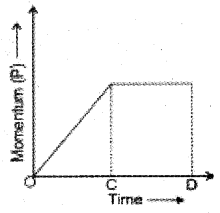
Question 22.
When a horse suddenly starts moving, the rider falls backward. (MARCH-2016)
a) Name and state the law used to explain the above situation.
b) State the law of conservation of linear momen turn and prove it on the basis of second law of motion.
c) State true or false.
An iron ball and a wodden ball of the same radius are released from a height in vaccum; the iron
ball will reach the ground first.
Answer:
a) Newtons’third law. For every action, there is equal and opposite reaction
b) According to law of conservation of linear momentum, if the external force acting on a body is zero, total linear momentum remains constant. According to Newton’s second law

c) False
Question 23.
A person drives a car along a circular track on a level ground. (MAY-2016)
a) Derive an expression forthe maximum safe speed of the car.
b) Why do we give banking to curved roads?
Answer:
a)

Considers vehicle moving overa level curved road. The two forces acting on it are
1) Weight (mg) vertically down
2) The reaction (N) required for circular motion. The centripetal force for circular motion is provided by friction. This friction opposes the motion of the car moving away from the circular road. Hence condition for circular motion can be written as Centripetal force ≤ force of friction
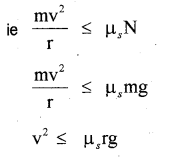
The maximum speed of circular motion of the car
![]()
In a curved level road, centripetal force forthe vehicle is provided by friction. This limits the maximum speed V = \(\sqrt{u r g}\) This defect can be solved by raising the outer edge of the road slightly above the inner edge. This process is called banking of road. In a banked curved road centripetal force is provided by a component of friction and component of normal reaction.
Question 24.
The schematic diagram of the circular motion of a caron a banked road is shown in the figure. (MARCH-20127)
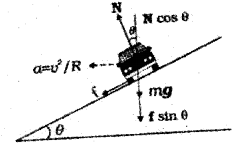
a) If the centripetal force is provided by the horizon
tal components of ‘N’ and ‘f arrive at an expression for maximum safe speed.
b) The optimum speed of a car on a banked road to avoid wear and tear on its tyres is given by ….

Answer:
a) Optimum speed is the speed at which a vehicle can move over a curved banked road without using unnecessary friction.
When a car is moved with optimum speed V0, μ can be taken as zero.
putting μ = 0 in the above equation we get

